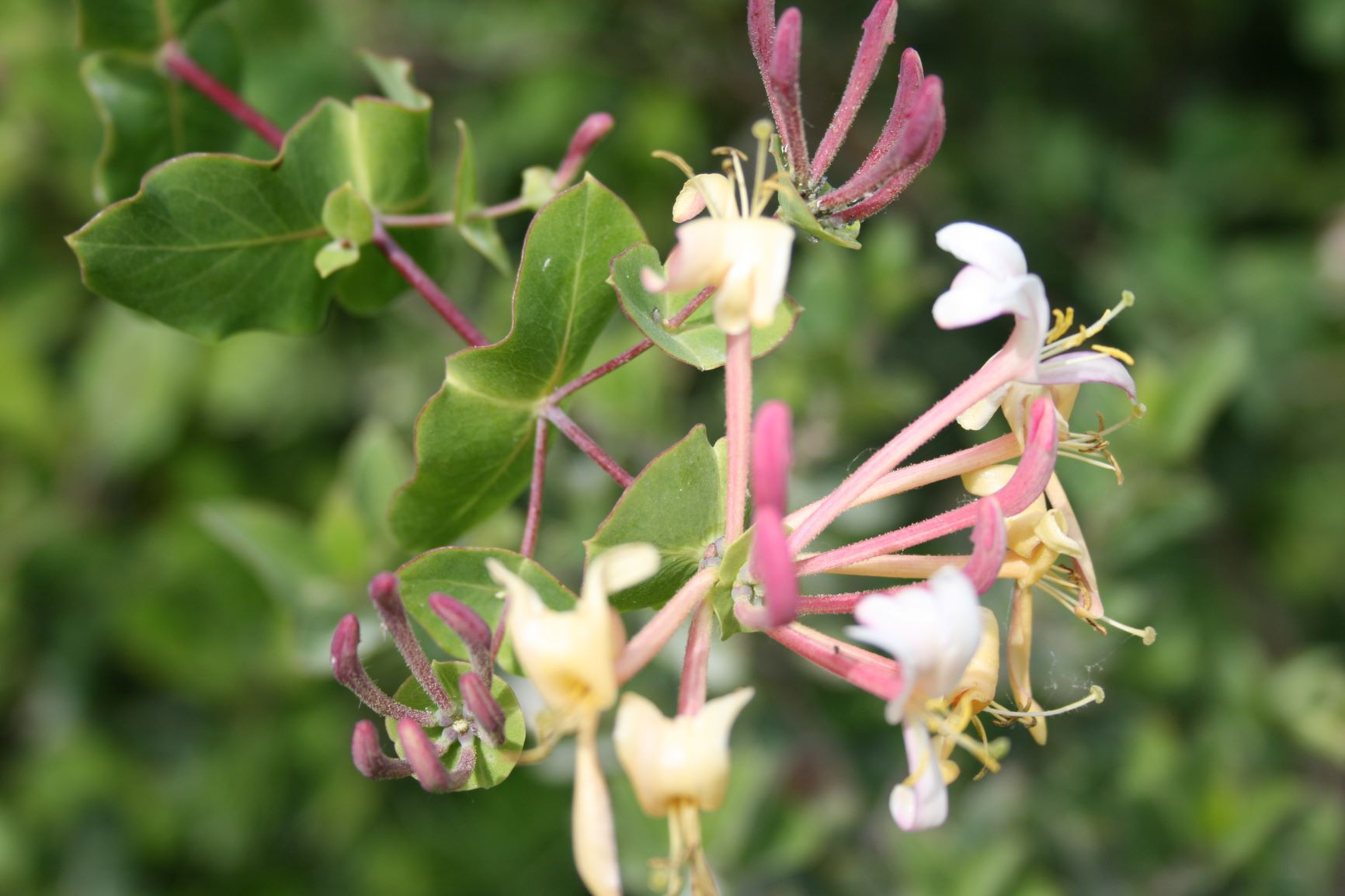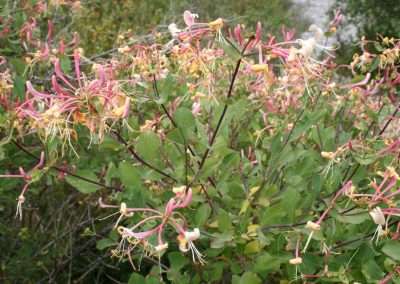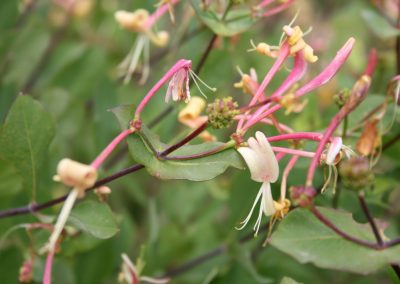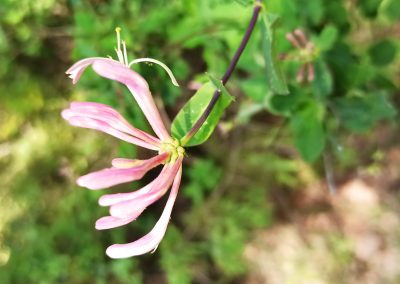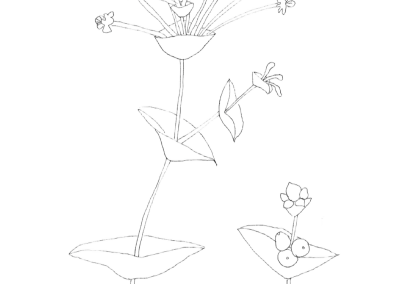Lonicera etrusca
Scientific description
Taxon: Lonicera etrusca
Class: Magnoliopsida (Dicotyledons)
Subclass: Asterids
Order: Dipsacales
Family: Caprifoliaceae
Common name: Etruscan honeysuckle
Origin:
Southern Europe, Mediterranean region.
Description:
Climbing subshrub 1–3 m with twining stems, glabrous or pubescent. Deciduous, obovate leaves; upper leaves sometimes connate. Highly fragrant flowers yellowish-white inside, reddish outside, in terminal whorls with long peduncles. Calyx with subacute teeth; glabrous corolla tube longer than lobes. Fruits ovoid red berries.
Propagation:
Seeds or semi-woody cuttings in summer; may also propagate via natural layering.
Ecology:
Mediterranean species, woodland edges, dry scrub, sunny slopes. Prefers calcareous, well-drained soils.
Uses:
Ornamental for fragrant flowers. Not edible.
Threats:
Least Concern; locally threatened by deforestation and habitat loss.
Taxon: Lonicera etrusca
Classe: Magnoliopsidées (Dicotylédones)
Sous-classe: Astéridées
Ordre: Dipsacales
Famille: Caprifoliacées
Nom commun: Chèvrefeuille d’Étrurie
Origine:
Sud de l’Europe, région méditerranéenne.
Description:
Sous-arbrisseau grimpant 1–3 m, tiges volubiles, glabres ou pubescentes. Feuilles caduques obovales; supérieures parfois connées. Fleurs très odorantes, blanc-jaunâtre à l’intérieur, rougeâtres à l’extérieur, en verticilles terminaux longuement pédonculés. Calice à dents subaiguës; corolle glabre avec tube plus long que le limbe. Fruits : baies rouges ovoïdes.
Multiplication:
Semis ou bouturage semi-ligneux en été; marcottage naturel possible.
Écologie:
Espèce méditerranéenne des lisières, maquis, pentes sèches exposées. Sols calcaires bien drainés.
Utilisation:
Plante ornementale pour fleurs parfumées. Non comestible.
Menaces:
Préoccupation mineure; localement menacée par déforestation et perte d’habitat.
Taxon: Lonicera etrusca
Clasă: Magnoliopsida (Dikotiledonate)
Subclasă: Asteridae
Ordin: Dipsacales
Familie: Caprifoliaceae
Denumire populară: Caprifoi etrusc
Origine:
Sudul Europei, regiunea mediteraneană.
Descriere:
Arbust cățărător 1–3 m, tulpini volubile, glabre sau pubescente. Frunze caduce obovale; superioarele uneori unite. Florile foarte parfumate, alb-gălbui interior, roșiatice exterior, în verticile terminale lung pedunculate. Caliciu cu dinți subascuți; corolă glabră, tub mai lung decât lobii. Fructe bace roșii ovale.
Propagare:
Semințe sau butași semi-lemnoși vara; marcotaj natural posibil.
Ecologie:
Specie mediteraneană, margini de păduri, tufișuri uscate, pante însorite. Preferă soluri calcaroase, bine drenate.
Utilizare:
Ornamental datorită florilor parfumate. Fructele nu sunt comestibile.
Amenințări:
Risc scăzut; local afectată de defrișări și pierderea habitatelor naturale.
Ταξινόμηση: Lonicera etrusca
Κλάση: Magnoliopsida (Δικοτυλήδονα)
Υποκλάση: Αστερίδες
Τάξη: Dipsacales
Οικογένεια: Caprifoliaceae
Κοινή ονομασία: Αγιόκλημα της Ετρούσκα
Προέλευση:
Νότια Ευρώπη, Μεσογειακή περιοχή.
Περιγραφή:
Αναρριχώμενος θάμνος 1–3 μ., βλαστοί περιελισσόμενοι, άτριχοι ή τριχωτοί. Φύλλα φυλλοβόλα, ανεστραμμένα ωοειδή, άνω φύλλα ενωμένα. Πολύ αρωματικά άνθη, λευκοκίτρινα εσωτερικά, κοκκινωπά εξωτερικά, σε σπονδύλους στις άκρες. Κάλυκας με υποαιχμηρά δόντια, στεφάνη άτριχη με σωλήνα μεγαλύτερο από πέταλα. Καρποί ωοειδείς, κόκκινοι.
Πολλαπλασιασμός:
Σπόροι ή ημιξυλώδη μοσχεύματα καλοκαίρι. Φυσική καταβολάδα δυνατή.
Οικολογία:
Τυπικό μεσογειακό φυτό, άκρες δασών, θαμνώνες, ξερά πρανή, ασβεστολιθικά καλά στραγγιζόμενα εδάφη.
Χρήση:
Καλλωπιστικό για αρωματικά άνθη. Όχι εδώδιμο.
Απειλές:
Ελάχιστης ανησυχίας, τοπικά απειλούμενο από αποψίλωση και καταστροφή φυσικών ενδιαιτημάτων.
Creative writing inspired by Lonicera etrusca
Etruscan honeysuckle
Once upon a time, a man named Jérôme came from Rome to the fairy world of Josette because his mother was very ill. He was attached to his mother because his father had abandoned them at an early age and had learned to live alone with her. And he would do anything to save her, for her existence gave meaning to his life. So he went to the fairy to ask for a remedy: the Etruscan honeysuckle plant, which didn't exist in his world.
Suddenly, as he made his way to the fairy's house, he heard a horrible scream and began to fear, but he remained calm as a tree, full of wisdom. Then the terrible Samos, tyrannical king of the fairy world, opened the door. Jérôme knew at once that it was an evil man. Samos, without saying hello, said: “You must pass a test to have this fruit, for it is unique in the world.”
Jérôme met the fairy Josette and begged her to help him save his mother from her serious illness. Samos, moved by the story, finally gave in and agreed. Jérôme set off with the plant, saved his mother and planted the seeds. Later, the plants flowered and bore fruit to commemorate life. He watered them every day and took good care of them.
It's from this story that we know the fabulous tree that goes by the name of Etruscan honeysuckle.


